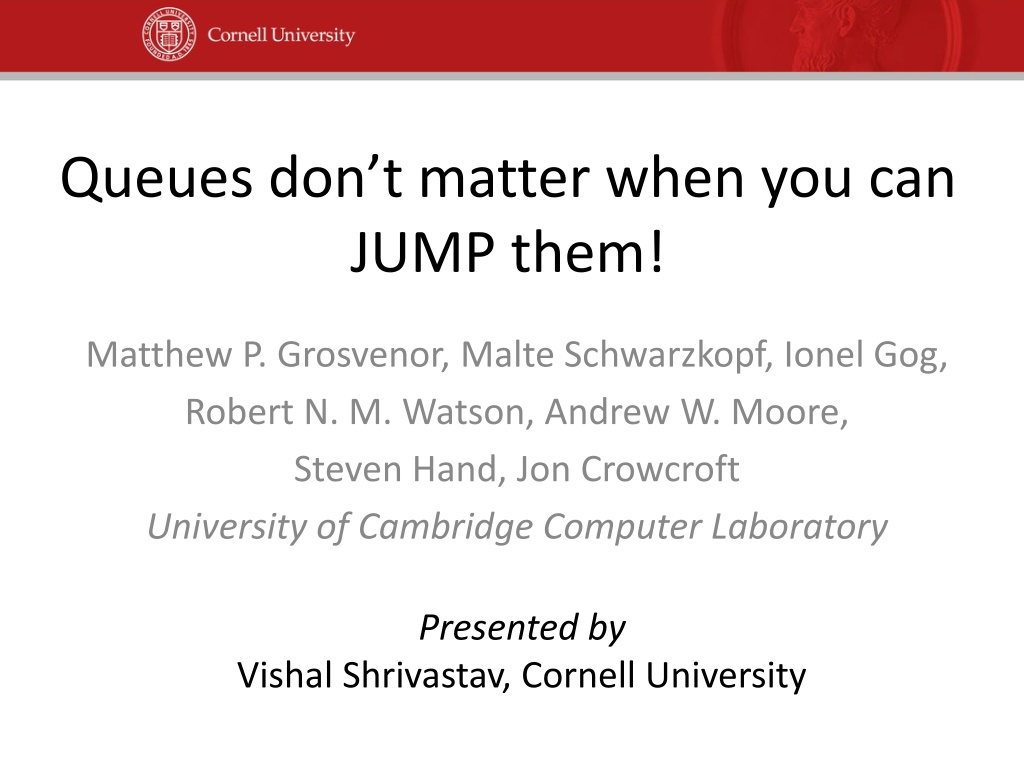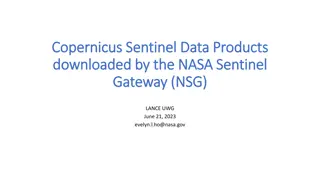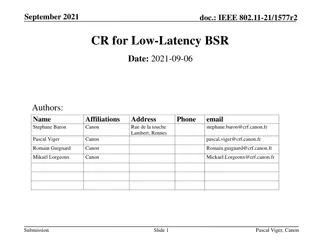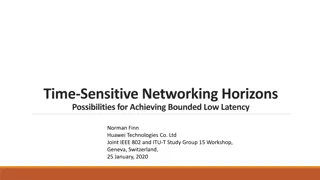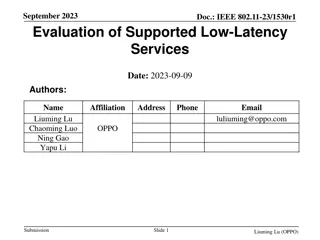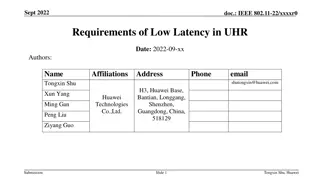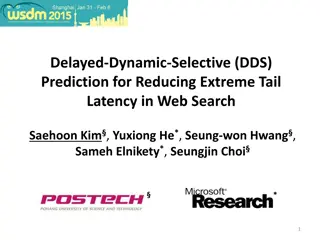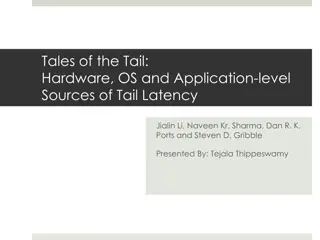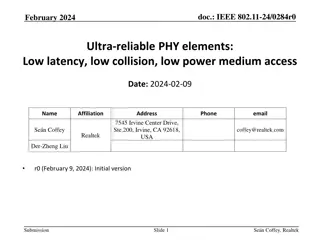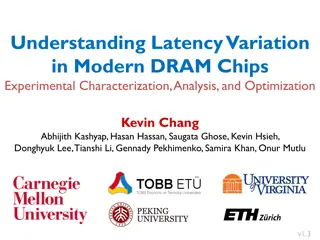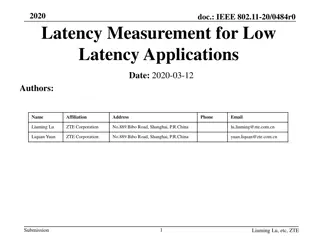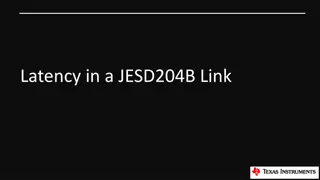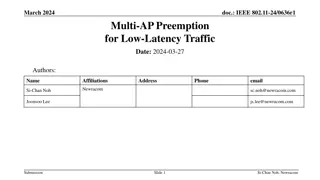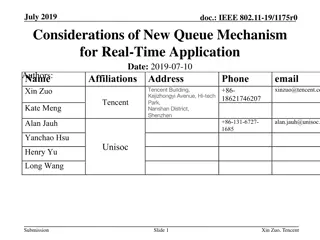Achieving Bounded Latency in Data Centers: A Comprehensive Study
Data centers face challenges in providing consistent low latencies due to in-network interference and varying workloads. This study explores solutions to guarantee strong latency performance, mitigate latency variance, and minimize performance degradation for latency-sensitive applications. By analyzing the causes of latency variance and implementing strategies like proactive rate-limiting, the research aims to achieve bounded latency and enhance user experience in modern data center environments.
Download Presentation

Please find below an Image/Link to download the presentation.
The content on the website is provided AS IS for your information and personal use only. It may not be sold, licensed, or shared on other websites without obtaining consent from the author. Download presentation by click this link. If you encounter any issues during the download, it is possible that the publisher has removed the file from their server.
E N D
Presentation Transcript
Queues dont matter when you can JUMP them! Matthew P. Grosvenor, Malte Schwarzkopf, Ionel Gog, Robert N. M. Watson, Andrew W. Moore, Steven Hand, Jon Crowcroft University of Cambridge Computer Laboratory Presented by Vishal Shrivastav, Cornell University
Introduction Datacenters comprise of varying mixture of workloads some require very low latencies, some sustained high throughput, and others require some combination of both Statistical Multiplexing leads to in-network interference can lead to large latency variance and long latency tails leads to poor user experience and impacts revenue How to achieve strong (bounded?) latency guarantees in present day datacenters? 2
What causes latency variance? Queue build-up packets from throughput intensive flows block a latency-sensitive packet Need a way to separate throughput intensive flows from latency- sensitive flows Incast packets from many different latency-sensitive flows hit the queue at the same time Need a way to proactively rate-limit latency-sensitive flows 3
Setup 1 server running ptpd v2.1.0 synchronizing with a timeserver 1 server generating mixed GET/SET workload of 1 KB requests in TCP mode sent to memcached server 4 servers running 4-way barrier-synchronization benchmark using Naiad v0.2.3 benchmark 8 servers running Hadoop, performing a natural join between two 512 MB data sets (39M rows each) 4
How bad it really is? CDF In-network interference can lead to significant increase in latencies and eventual performance degradation for latency- sensitive applications CDF 5
Towards achieving bounded latency Servicing delay Time since a packet got assigned to an output port to when it is finally ready to be transmitted over the outgoing link Packets fanning in to a 4-port, virtual output queued switch. Output queues shown for port 3 only. Servicing delay is a function of the queue length 6
Maximum servicing delay Assumptions Entire network abstracted as a single big switch Initially idle network Each host connected to the network via a single link Link rates do not decrease from edges to network core ????? ???? ????????? ????? ? ? ? + ? n = number of hosts P = maximum packet size R = bandwidth of slowest link ? = switch processing delay 7
Rate-limiting to achieve bounded latency Network epoch maximum time that an idle network will take to service one packet from every sending host ??????? ???? = 2? ? ? + ? All hosts are rate-limited so that they can issue atmost one packet per epoch bounded queuing => bounded latency epoch 1 epoch 2 8
What about throughput? Configure the value of n to create different QJump levels n = number of hosts -- highest QJump level bounded latency; very low throughput n = 1 -- lowest QJump level latency variance; line rate throughput 9
QJump within switches Datacenter switches support 8 hardware enforced priorities Map each logical QJump level to physical priority level on switches Highest QJump level mapped to highest priority level on switches and so on Packets from higher QJump levels can now jump the queue in the switches 10
Evaluation CDF - Naiad barrier sync latency QJump resolves in-network interference and attains near-ideal performance for real applications CDF - Memcached request latency 11
Simulation : Workload In web search workload, 95% of all bytes are from 30% of the flows that are 1-20 MB In data mining workload, 80% of flows are less than 10KB and 95% of all bytes are from 4% of the flows that are >35 MB 12
Simulation : Setup QJump parameters Maximum bytes that can be transmitted in an epoch (P) = 9KB Bandwidth of slowest link (R) = 10Gbps QJump levels = {1, 1.44, 7.2, 14.4, 28.8, 48, 72, 144} varying value of n from lowest -> highest level 13
Simulation : Results For short flows, on both workloads, QJUMP achieves average and 99th percentile FCTs close to or better than pFabric For long flows, on web search workload, QJump beats pFabric by up to 20% at high load, but loses by 15% at low load For long flows, on data mining workload, QJump average FCTs are between 30% and 63% worse than pFabric s 14
Conclusion QJump applies QoS-inspired concepts to datacenter applications to mitigate network interference Offers multiple service levels with different latency variance vs. throughput tradeoffs Attains near-ideal performance for real applications in the testbed and good flow completion times in simulations QJump is immediately deployable and requires no modifications to the hardware 15
Final thoughts The Good can provide bounded latencies for applications that require it does a good job of resolving interference via priorities immediately deployable The Bad QJump levels are determined by applications (instead of automatic classification) and The Ugly no principled way to figure out rate limit values for different QJump levels 16
Discussion 1. Are we fundamentally limited by statistical multiplexing when it comes to achieving strong guarantees (latency, throughput, queuing) about the network? 2. Is it reasonable to trade-off throughput for strong latency guarantees? Resource disaggregation Rack-scale computing Controllers: IO, memory... CPU NIC/Packet switch SoC d ports Network Boston Viridis Server = Calxeda SoC 900 CPUs 17
Thank you! 18
